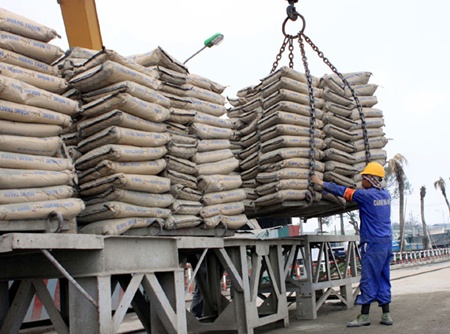
| Cement industry on path to recovery | |
The country’s cement market has seen positive results after a long, quiet period, with both domestic cement consumption and exports having increased. According to the Viet Nam National Cement Association, domestic cement consumption in the first five months of the year reached 20.42 million tonnes, posting a 9.3 per cent increase over the same period last year. Last month alone, cement consumption in the country was estimated at 4.87 million tonnes, increasing 12 per cent against last May. Viet Nam shipped nearly two million tonnes of cement and clinker last month. The amount of exported cement in the five-month period was estimated at around seven million tonnes, posting 42 per cent year-on-year increase. The association chairman Nguyen Quang Cung predicted that the domestic cement consumption this year would reach 50 million tones, which would be equal to the amount in 2010, the highest level so far. The forecast for cement exports this year was expected to be 20 million tonnes. Many cement companies have also achieved good production and business results in recent times. FiCO Tay Ninh Cement Joint Stock Company Deputy General Director Trang Thanh Ba said that market demand has increased strongly and all plants currently have run at 100 per cent capacity. According to statistics, in the first four months of this year, the company sold 450,000 tonnes of cement, an increase of 10 per cent compared to the same period last year. In terms of the southern market, the company would provide about 1.5 million tonnes of cement in the whole year. Vicem Ha Tien 1 Cement Joint Stock Company said that the company has achieved good production and business results in recent times. Cement consumption in the first five months of this year increased compared to the same period last year. The company plans to sell about 4.9 million tonnes of cement and about 800,000 tonnes of clinker in 2014. However, the association said there were 70 investors who had poured capital into the sector. The number was too high as the country’s total cement output has been between 65 and 70 million tonnes, five to seven times higher than other countries in the region. A number of areas with rich limestone reserves such as Ha Nam, Ninh Binh and Thanh Hoa, along with Quang Ninh and Hai Phong would be advantageous for the cement industry. The location of the cement projects and financial capacity of investors will play a key role in the planning of the cement industry. The Government has removed nine unfeasible projects from the development plan of the country’s cement industry in 2011-20, as several investors were found incapable of financing their projects. Investors need to spend on advanced machinery and equipment, and contribute towards reducing coal and power consumption. They also need to control environment pollution, improve labour productivity and product quality. | |
| VIR |
